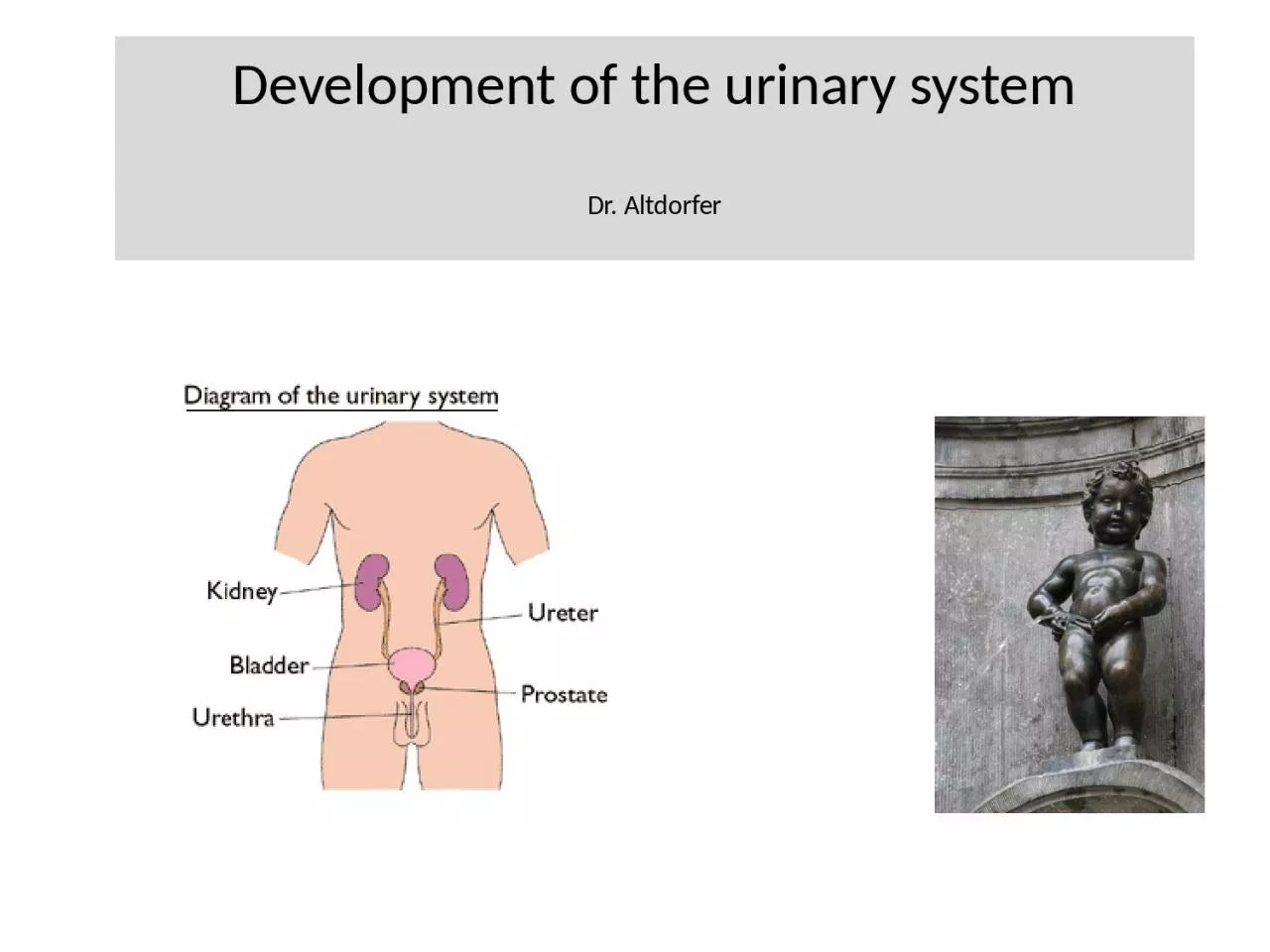

system Dr Altdorfer intermediate mesoderm Gononephrotom bladder and urethra from the urogenital sinus 1 Paraxial mesoderm 2 Intermediate mesoderm 3 ID: 1043876
Download Presentation The PPT/PDF document "Development of the urinary" is the property of its rightful owner. Permission is granted to download and print the materials on this web site for personal, non-commercial use only, and to display it on your personal computer provided you do not modify the materials and that you retain all copyright notices contained in the materials. By downloading content from our website, you accept the terms of this agreement.
1. Development of the urinary systemDr. Altdorfer
2.
3. -intermediate mesoderm (Gononephrotom), - bladder and urethra: from the urogenital sinus.1 Paraxial mesoderm2 Intermediate mesoderm3 Lateral mesoderm4 Notochord5 Amnion6 Intraembryonic coelom7 Endoderm8 Ectoderm9 Somatopleural (mesoderm and etoderm)10 Splanchnopleural (mesoderm and endoderm)11 Neural groove12 Neural ridgeDevelopment of the urinary organs (3rd - 4th week)
4.
5.
6.
7. 1234567UreterMajor calixMinor calixRenal pelvis Collecting ductMetanephric vesicle Kidney lobe89101113Distal tubuleProximal tubuleGlomerulusConnecting tubuleIntermediate tubule1232+345CloacaUreteric budMetanephric blastemaMetanephrosMesonephric duct (Wolffian duct)Nephrogenic cordMorphologic differentiation of the urinary tractThe ureter bud (Kupffer’s duct) is an epithelial diverticulum which arises from the mesonephric duct (Wolffian duct). Its enlarged end grows in cranial direction and projects into the metanephric blastema.It is the origin of the intra- and extrarenal urinary passages:Ureter Renal pelvis Major calicesMinor calices Papillary ductsCollecting ducts
8. URETERIC BUD
9. The URETERIC BUD secrets growth factors that stimulates differentiation of the metanephric blastema into glomeruli and kidney tubules (i.e. induces the blastema to undergo mesenchymal-to-epithelial transition ). Perturbations in any aspect of these inductive events may cause inhibition of ureteric bud growth and renal hypoplasia or agenesis. Conversely, duplication or overproliferation of structures can occur if there is a gain of function of the inductive factors.
10. POLYCYSTIC KIDNEYSPolycystic kidney: no fusion of nephron + collecting ducts.
11. 12345678910GonadMesonephrosAllantoisTuberculum genitaleCloacal membraneCloacaHindgutMetanephrosMesonephric duct(Wolffian duct)Ureteric budKidneys and ureters develop from the intermediate mesoderm (Gononephrotom), whereas bladder and urethra derive from the urogenital sinus.Cloaca differentiation: urogenital sinus + rectum2) Wolffian duct differentiation: ductus deferens + ureter
12. 12345678910GonadMesonephrosAllantoisTuberculum genitaleCloacal membraneCloacaHindgutMetanephrosMesonephric duct(Wolffian duct)Ureteric bud11: urogenital membrane12: anal membraneAscent of the kidneysCloaca differentiation: urogenital sinus + rectum2) Wolffian duct differentiation: ductus deferens + ureter
13. Development of the bladderThe bladder develops from the upper part of the urogenital sinus (UGS) and is connected with the allantois.The allantois is obliterated, forms a fibrous cord: the urachus following birth becomes the median umbilical ligament.The ureteral openings appear to migrate thereby in a cranio-lateral direction and the mesonephros orifices appear to be shifted caudo-medially. The triangular zone that is thus created is termed the vesical triangle. In males, the wolffian duct forms the future ductus deferens on both sides.The triangle of the bladder originates from mesoderm while the ventral bladder wall has an endodermal origin. Later, though, the trigonum will be completely covered by endodermal epithelial cells.
14. UROGENITAL SINUS
15. Malformations of the development of the urinary bladder
16. Growth of the embryo kidneys to “ascend” to the lumbar region. kidneys get always new blood vessels cranially - then induce the regression of the more caudal branches. Malformations related to the ascent of the kidneysPelvic kidney (A): one or both kidneys stays in the pelvisHorseshoe kidney (B): the two developing kidneys fuse ventrally into a single, horseshoe shape that gets trapped in the abdomen by the inferior mesenteric artery.Supernumerary arteries (C): can often have more than one renal artery per kidney, which is often asymptomatic but can sometimes compress the ureter
17. Ectopic kidney: problem with the ascent(Kidney transplants are also made „ectopic”.)
18. Horseshoe-kidney
19.
20. Ureter duplex: 2 ureteric buds on one side
21.